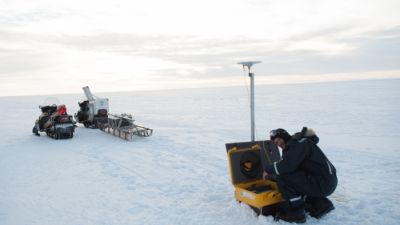
Be:Wise -The Buttressing Effect: Why ice shelves are essential
The Be:Wise project aims to improve understanding of ice-shelf flow dynamics by focusing on the buttressing role of ice rises and pinning points – small offshore mountains which support Antarctic ice shelves from underneath.
Glaciolgist Reinhard Drews' Be:Wise project, which earned him this year's InBev-Baillet Latour Antarctic Fellowship, will study the flow dynamics of the Roi Baudouin ice-shelf, which buttresses ice flow from East-Antarctica’s ice sheet. The project is expected to provide important insights into the rapid fluctuations of historical ice discharges, and provide data for improving capacity of ice-flow models, in order to better forecast the balance of the Antarctic ice sheet mass balance in a warming world.
The project consists of two four-week long field campaigns on the Roi Baudouin ice shelf during two Antarctic seasons, which started in November 2012, when Be:Wise examined the ice-dynamical role of grounded features, which are enclosed by the ice shelf, and which buttress the ice flow from the East-Antarctic ice sheet. Since almost three quarters of the Antarctic ice sheet boundary is in contact with the ocean, this case study is expected to contribute to the overall understanding of the Antarctic mass balance.
The Roi Baudouin ice shelf is confined by two ice rises with a local flow regime, and two pinning-points with a width of only a few kilometres; the latter seems to define the seaward edge of the ice shelf and impact ice-flow in the hinterland.
The Be:Wise project aims to investigate the connection between the flow-dynamics of the ice shelf with the locally grounded counterparts, by combining satellite remote sensing with on-site ground-penetrating radar and GPS measurements. The project also envisages geophysical parameters such as strain-rates, internal ice properties, surface velocities and characteristics of the bedrock interface. Preliminary studies indicate that the pinning-points of the Roi Baudouin ice shelf become partially afloat during high tide. Therefore, satellite images can be analysed which directly measure the effect of a de- and re-attachment from an ice shelf to a pinning point. This, and the proximity to the Princess Elisabeth station which enables on-site field measurements, make the Roi Baudouin ice shelf a unique field site for a case study, as it delivers important insight into the operation of the buttressing effect.
Larger-scale effect of ice-shelf buttressing, in terms of grounding-line migration and/or in terms of controlling the mass flux from the grounded ice sheet, are not fully understood. However, since the contact area between the ice shelf and local highs in bedrock elevation is susceptible to changing ocean characteristics, it is important to quantify this buttressing effect, in order to evaluate whether or not it is a key to understand rapid (~ centennial ) variations in ice-sheet geometry.
Since the ice-sheet mass balance is tightly linked to the overall sea level, this will help to better explain sea-level variations in the past and eventually contribute to forecasting the sea level rise in a warming world.
Work during the BELARE expeditions
During the 2013/2013 Antarctic season, the Be:Wise team will attempt to locate all 25 Markers which we left anchored in the ice during the previous season. In the intervening time, the markers move with the flow of the ice. After one year, by taking measurements between positions of the markers, it is clear just how much the ice has deformed.
The team will also carry out "Common Midpoint Surveys" with Radar, enabling a vertical velocity profile of the electromagnetic wave within the ice. This provides the means to deduce the vertical density profile and lateral variations thereof, in order to to determine the ice thickness via the freeboard height using hydrostatic equilibrium (the Archmides Principle). The Be:Wise team wish to establish whether marine ice is frozen to the ice shelf from below.
Be:Wise also plans to carry ou additional radar profiling and GPS measurements to better understand the role of the "trenches", which are visible on the image on the left side of the pinning point. Do they influence the ice deformation and if so by how much?
Picture: Glaciologist Reinhard Drews installing a GPS station on the Roi Baudoin ice shelf - © International Polar Foundation
